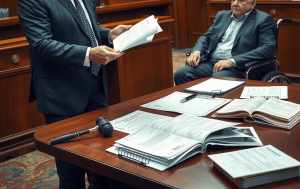In an Illinois personal injury lawsuit, to meet the burden of persuasion, a plaintiff must put on evidence. Evidence comes in many forms, including testimony, paper records, photographs, digital recordings, and even physical objects (like faulty car parts). This post takes a quick look at three common types of evidence in personal injury lawsuits: police reports, witness testimony, and medical records.
Although those three types of evidence won’t necessarily be available in every case, when they are available, they will be among the most important evidence in persuading a defendant to settle or a jury to find in the plaintiff’s favor.
Police Reports
Police reports are documents prepared by the police responding to the scene of an accident. The police will record what they believe caused the accident and which driver they think was most at fault. Police reports are not generally admissible in court, but they can help convince an insurance company that its driver was to blame, making it more likely that it will choose to settle the case.
Note that a police report is different from a traffic crash report. In Illinois, if you’re involved in a motor vehicle accident that results in death, bodily injury, or more than $1,500 in property damages (or more than $500 if any driver involved has no insurance), then you must file an Illinois traffic crash report. You should always call the police if you’re involved in an accident so that they can prepare a formal police report.
Witness Testimony
When most people think of trial evidence, they think of witness testimony. Witness testimony comes in two broad types: lay (i.e., non-expert) testimony and expert testimony.
Lay testimony is typically provided by eyewitnesses—witnesses who saw what happened and can explain that to the jury. However, non-witnesses may also be needed to proving the authenticity of physical evidence or establish a hearsay exception for outside records to be used as evidence in court. One limitation for lay witnesses is that they usually cannot offer opinions—only facts.
In contrast, experts are given a wider degree of latitude, in that expert witnesses are allowed to offer opinion testimony—for example, that a doctor committed malpractice. Expert testimony can help to prove the extent of damages a person suffered, given that not every injury is obvious to outside observers. In medical malpractice cases, expert testimony is almost always required to prove liability.
Medical Records
Medical records are critical evidence in personal injury cases. They help demonstrate the extent of an injury and the amount spent for past medical care. In medical malpractice cases, medical records take on an even more important role: They help prove that the doctor or other professional failed to live up to the standard that the law requires.
Illinois and federal law protect a person’s right to access and copy his or her medical records. In Illinois, 735 ILCS 5/8-2001 protects that right. That law also permits a healthcare provider to charge reasonable expenses in copying any such records, but the amount that can be charged is limited.
Building a Strong Case Requires Help
Of course, these are just some of the big-ticket items that an Illinois personal injury lawyer will look for to help develop a case.Every case is different, and a good lawyer will diligently investigate what evidence is available and determine how to acquire it. If you’ve been injured by another person’s wrongful act, contact one of the experienced personal injury lawyers at Costa Ivone today for help identifying and gathering evidence in your case.





